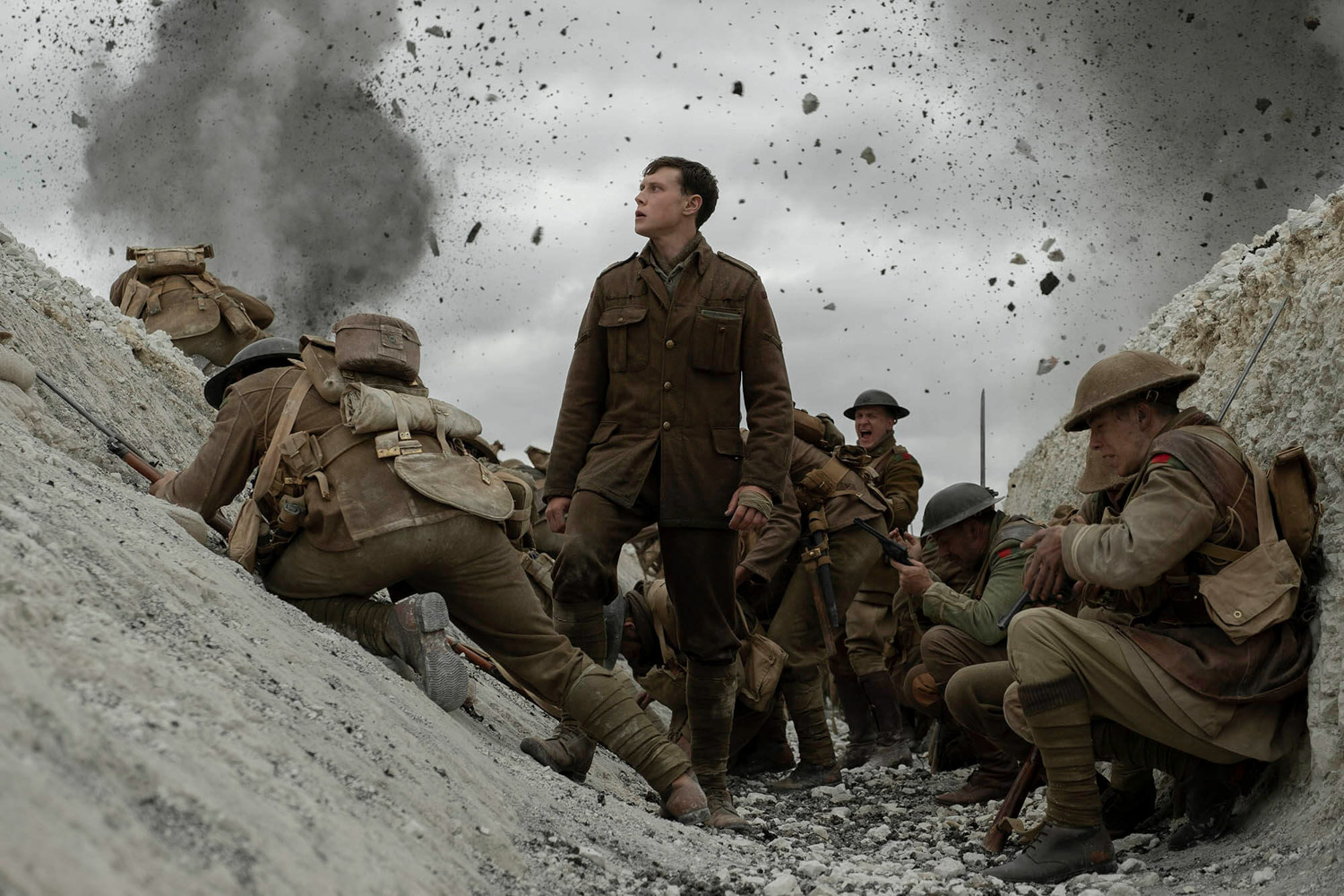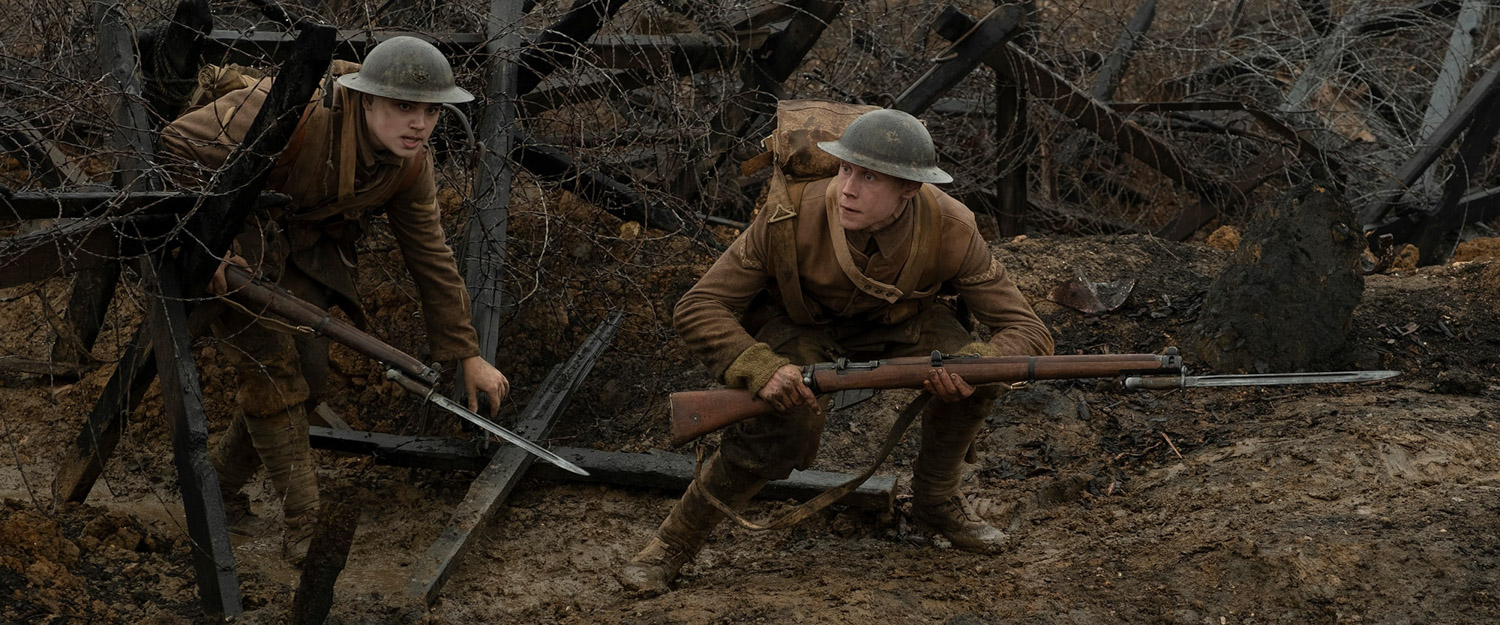War in vivid detail
’1917’ provides woeful portrayal of World War I
January 15, 2020

Schofield (George MacKay) looks outside trench as fellow British soldiers hide from incoming shells. Photos courtesy of Universal Pictures.
Germans roam the streets of the French city of Écoust as Schofield (George MacKay) silently walks about the streets dodging German patrols. Then he is spotted and has no choice, he must jump into a river barely escaping with his life.
“1917,” directed by Sam Mendes, tells a fictional story based off of stories Mendes’ grandfather told him as a child.
During WWI, two British soldiers, Lance Corporal Will Schofield and Lance Corporal Tom Blake (Dean-Charles Chapman) are sent on a mission. They must venture into former German territory to warn the second battalion to disengage their attack on the new German lines. To make matters worse for Blake, the mission is personal: his brother is in the second battalion.
At first glance, this film seems similar to stories like “Saving Private Ryan” (1998) that feature phenomenal action scenes and emotionally gripping stories.
This movie diverges from those films in that it does not shy away from displaying the sheer brutality of war while also having a story that is one of the most disheartening stories of the past few years in the war genre.
“1917” accomplishes this primarily through not shying away from showing the damage war has done and going to an extent rarely seen previously.
In some of the first moments of the film, the audience is introduced to the scary aftermath of what the trenches and the soldiers in them experienced.
When Schofield and Blake end up crossing into no man’s land, the film unapologetically shows the products of warfare: dead rotting horse carcasses, human bodies yet to be collected and rusting tanks surrounded by muddy craters left behind from consistent shelling of the terrain.
This graphic depiction is something that previous war films have either not attempted or not been able to pull off due to technical, financial, or rating limitations. Consequently, 1917 stands out as a depiction of WWI that undoubtedly captures the atmosphere of warfare and creates an understanding of the strain the characters undergo.

Schofield (George MacKay) and Blake (Dean-Charles Chapman) cautiously cross fields of bard wire fences. Photos courtesy of Universal Pictures.
The cinematographic approach of using one continuous shot also helps build this graphic depiction of warfare. There are no cuts. Even in the quietest moments of the film what the audience sees is the action on screen unfolding as the characters experience it.
The struggle Schofield and Blake have to go through to deliver the orders is also one of the most impactful parts of the film. While the movie, for the most part, featured less action due to the German retreat leaving the area mostly abandoned, “1917” was still able to capture a tense and suspenseful story.
Walking into the unknown and not having any intelligence other than the fact that the Germans pulled out, these men have to go through trenches, hills, churches and cities once occupied by Germans.
At each of these obstacles there is something left by the Germans, whether a trap, German pilots or stragglers remaining in the unoccupied territory.
Schofield and Blake truly do not know what they will have to face and, as only two men in a territory where there could be still hundreds of men, their fears and inner conflicts are evident.
They also must deal with the very real possibility of running out of time as the attack on German forces happens the next morning giving them only one night to reach the 2nd battalion and save thousands of lives. This added piece of a race against the clock, while not an unusual method to move the plot forward, is cleverly used in “1917” to build tension and keep the action going even in some moments when it starts to seem like nothing is happening — similar to the 2017 WWII film “Dunkirk.” It leads to a feeling that, even when the most dark and shocking moments of the film occur, the characters have to continue on in an attempt to make their sacrifices worth it.
Through the combination of the grave, vivid depiction of WWI warfare and the emotionally distressing story of Schofield and Blake, “1917” is an outstanding war film that pushes the genre outside of its norms while also staying true to its foundation: emotion and grit.


























































































Jeremiah Agware • Dec 6, 2021 at 7:42 am
I do spend most of my free time watching movies and TV series. It’s almost like I don’t have a life after work and movies I agree with you on this and keep up the good work.